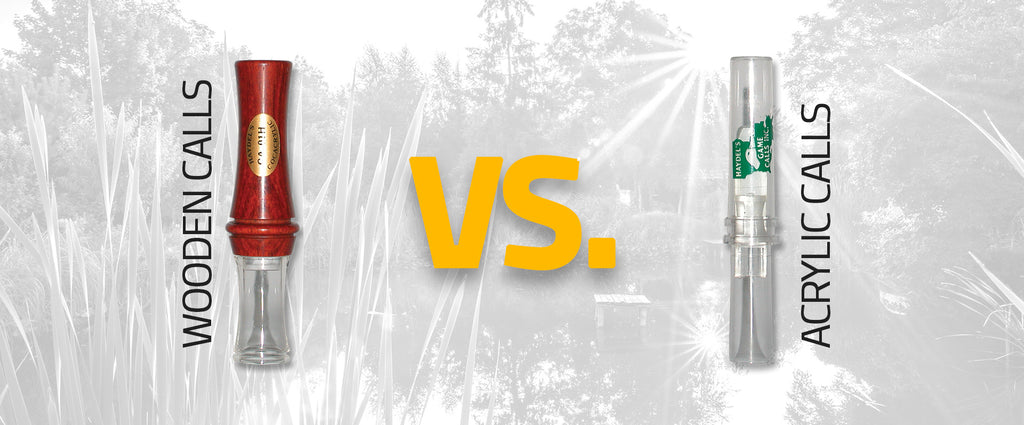Haydel's Blog
Breaking the Tradition - Wood vs. Acrylic

What’s the deal nowadays with acrylic calls? Their popularity has grown to overwhelming proportions in the last few years. Is it because of them being so widely used in competition or are most people actually using them in the field? Question is do you need one. Let’s explore the differences between wood and acrylic.
Twenty years ago when we started our business wood calls were the norm. Dads’ handed down their traditional wooden calls to their kids. Plastics were new and a hard sell. We decided in the very beginning that we wanted a call that would not stick and a material that was consistent from call to call. Acrylic definitely fits these criteria over wood due to the nature of the grain structure and the fact that there in nothing to swell when wet. After all, acrylic is just a form of plastic.
Let’s look at the differences and compare apples to apples. We currently make three different calls in our extensive line that are identical in shape and size except for the materials. One is wood ($85.00), one acrylic ($115.00) and the other our standard plastic ($34.95). The wood and acrylic are turned pieces and the plastic is injection molded. I am constantly asked why acrylic is so expensive. It is not in its natural state. The cost comes in the form of labor. Both wood and acrylic have to be turned on a lathe. The acrylic then has to be buffed to remove all the scratches and make the call transparent. This is very time consuming and the reason for acrylic calls being so pricey--- the labor.
Sound is where the difference comes in. Overall, wood tends to be real ducky sounding depending on the specie of wood used as well as the individual piece. Exotic woods tend to have more variety in sound such as tulip, ebony, and rosewood. I remember dad having a contest call out of rosewood that was an awesome call till the call just died one day before a contest. No matter what he did he could not revive it. The structural composition must have had changed as the call remains dull and not bright as it did in it glory. Bois-de-ark and walnut are pretty consistent as well as cocobolo. Some of my favorites have also included cedar for its ducky sound but it isn’t very durable and cocus wood which when you can find it is extremely pricy. Cocus is used I am told in many fine instruments such as high-end clarinets and oboes. When wood gets wet the grain rises changing the tolerances in the relationship between the sound tunnel and reed; this totally changes the sound. This is the reason for sticking developing after a call has been blown awhile. One of the things that we do to compensate for this is to use plastic parts on the inside of the call, thereby eliminating any chance for swelling to develop in these tight tolerances.>script sr
Acrylic when compared for sound with wood tends to be a brighter sound hence it’s usually slightly higher pitch. It seems to work great for hail calls of a contest call as well as for long distance work in a blind. For some that may hunt off of natural flyways or on those special “flight days”… the louder the better. I personally favor a higher pitch call most of the time till ducks get a little call shy late in the season. Then I just back off or use a lower pitched call. Don’t confuse higher pitched with louder. Both are two separate qualities that operate individually of one another.
Injected plastic seems to be the best of both worlds and will handle most hunting situations on a day to day basis just fine. It has the duck and versatility to be blown with that higher pitch. Again this is comparing our calls with all things being equal except for materials… apples to apples.
Combinations of these various materials are also available in the market place as we are this year even introducing a new call by combining a hand turned cocobolo, blowing barrel with an injected acrylic end piece. This new “cocacrylic” combination gives you the feel of wood, the sound of acrylic at a price that is affordable to anyone.
Some days the ducks like one thing and others maybe another. That is why you see guys with so many calls around their necks---in order to be versatile. Some favor acrylics in competition, but an awful lot are getting use in the field as well. Now I’d like to sell everyone of you a nice acrylic call and I am fortunate to be able to blow what ever I’d like but if anyone ever wanted to know what I personally blow in the blind… 99% of the time it’s a $15.00 injected plastic call.









